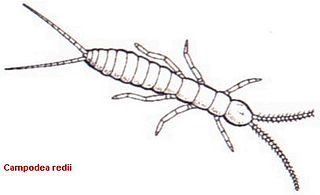
The wildcat is a species complex comprising two small wild cat species, the European wildcat and the African wildcat. The European wildcat inhabits forests in Europe and the Caucasus, while the African wildcat inhabits semi-arid landscapes and steppes in Africa, the Arabian Peninsula, Central Asia, into western India and western China. The wildcat species differ in fur pattern, tail, and size: the European wildcat has long fur and a bushy tail with a rounded tip; the smaller African wildcat is more faintly striped, has short sandy-gray fur and a tapering tail; the Asiatic wildcat is spotted.

The japygids are a taxon of hexapods, of the order Diplura, commonly known as forcepstails.

The European wildcat is a small wildcat species native to continental Europe, Scotland, Turkey and the Caucasus. It inhabits forests from the Iberian Peninsula, Italy, Central and Eastern Europe to the Caucasus. Its fur is brownish to grey with stripes on the forehead and on the sides and has a bushy tail with a black tip. It reaches a head-to-body length of up to 65 cm (26 in) with a 34.5 cm (13.6 in) long tail, and weighs up to 7.5 kg (17 lb).

The Machilidae are a family of insects belonging to the order Archaeognatha. There are around 250 described species worldwide. These insects are wingless, elongated and more or less cylindrical with a distinctive humped thorax and covered with tiny, close-fitting scales. The colour is usually grey or brown, sometimes intricately patterned. There are three "tails" at the rear of the abdomen: two cerci and a long central epiproct. They have large compound eyes, often meeting at a central point. They resemble the silverfish and the firebrat, which are from a different order, Zygentoma.

The Campodeidae are a family of hexapods belonging to the order Diplura. These pale, eyeless hexapods, the largest of which grow to around 12 mm in length, can be recognised by the two long, many-segmented cerci at the end of the abdomen. Abdominal spiracles are absent.
Japyx is a genus of diplurans belonging to the family Japygidae. These eyeless, predatory hexapods largely shun direct sunlight, remaining under stones and among detritus, where they use pincer-like cerci to catch their tiny prey.
Coregonus confusus is a freshwater whitefish from Switzerland. It is also known by its native Swiss German common name, spelled pfärrit, pfarrig, and pfärrig. It was described as Coregonus annectens confusus by Victor Fatio in 1885 from syntypes which have been lost in 1902. The species is rare and only known with certainty from Lake Biel. There is also a possibility that it might occur in Lake Neuchâtel. It vanished from Lake Murten in the 1960s due to eutrophication and water level management.
Burmjapyx is a genus of diplurans in the family Japygidae.
Catajapyx is a genus of diplurans in the family Japygidae.
Indjapyx is a genus of diplurans in the family Japygidae.
Megajapyx is a genus of diplurans in the family Japygidae.
Mesjapyx is a genus of diplurans in the family Japygidae.
Metajapyx is a genus of diplurans in the family Japygidae.
Parholaspididae is a family of mites in the order Mesostigmata.
Ablerus is a genus of chalcid wasps formerly belonging to the family Aphelinidae. The genus was created by the American entomologist Leland Ossian Howard in 1894 for the species named in that year by William Harris Ashmead as Centrodora clisiocampae. The genus Azotus was synonymized with Ablerus by Alexandre Arsène Girault in 1913 and Hyatt synonymized Myocnemella with Ablerus in 1994, leaving Ablerus as the sole genus within the subfamily Azotinae. Azotinae was elevated in rank in 2013 to become the monotypic family Azotidae.
Catajapyx aquilonaris is a species of forcepstail in the family Japygidae.
Catajapyx ewingi is a species of forcepstail in the family Japygidae. It is found in North America.
Catajapyx singularis is a species of forcepstail in the family Japygidae.

Ips confusus, known generally as the pinyon pine beetle or pinyon ips, is a species of typical bark beetle in the family Curculionidae. It is found in Central America and North America.

Halictus confusus, the southern bronze furrow bee or confused sweat bee, is a species of sweat bee in the family Halictidae. It is a primitively eusocial bee species found in open habitats in Eurasia and North America.






